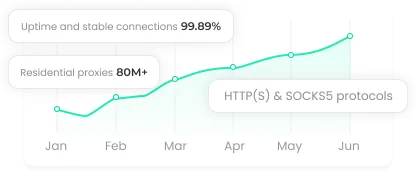SOCKS5 vs. HTTPS Proxies: A Deep Dive into Protocols
Every second, millions of data packets race across the internet. Some are carefully encrypted. Others zip along unprotected, vulnerable to prying eyes. If you care about privacy, speed, or bypassing network limits, the proxy protocol you choose can make or break your online experience. Two contenders dominate the conversation, SOCKS5 and HTTPS proxies. Both act as intermediaries, yet they handle traffic in completely different ways. Choosing the right one is not merely a technical matter but a strategic decision. Let's break it down.

The Overview of HTTPS Proxies
HTTPS proxies are built to handle web traffic securely. They wrap your data in SSL/TLS encryption, meaning sensitive information—passwords, banking details, confidential files—is hidden from prying eyes.
Your request goes to the HTTPS proxy first. The proxy forwards it to the destination website, grabs the response, and sends it back to you. During this journey, your real IP is masked. The result? Anonymity without compromising security.
HTTPS proxies aren't just about hiding your identity—they're about control. They can filter traffic, enforce content rules, and monitor usage. Companies use them to block malicious sites, cache popular pages, and streamline bandwidth. For anyone serious about web security, HTTPS proxies are a frontline tool.
Real-World Applications of HTTPS Proxies
Secure browsing: Keep personal information safe from hackers.
Regional access management: Navigate geo-restrictions without exposure.
Corporate security: Enforce internet policies and content filters.
Online transactions: Protect e-commerce and banking sessions.
Workflow automation: Combine with automation tools to maintain secure sessions for account management or social media campaigns.
HTTPS is a go-to choice whenever encryption and controlled web traffic are priorities.
The Overview of SOCKS5 Proxies
SOCKS5 operates differently. Instead of focusing on web encryption, it's about versatility and speed. It works at a lower level, handling multiple protocols—not just web traffic. TCP, UDP, FTP, email protocols, peer-to-peer applications—you name it, SOCKS5 can route it.
Unlike HTTPS, SOCKS5 does not inspect or modify your traffic. No filtering. No extra encryption overhead. That's why it's faster. And because it doesn't log metadata by default, privacy is preserved.
Real-World Applications of SOCKS5 Proxies
Gaming: Reduce latency, access foreign servers, maintain smooth gameplay.
Streaming: High-speed connections for geo-restricted content.
Web scraping and automation: Rotate IPs and stay anonymous while collecting data.
P2P file sharing: Supports UDP for efficient peer-to-peer connections.
Email and file transfers: Works seamlessly with FTP, SMTP, POP3.
When speed and multi-protocol support matter more than encryption, SOCKS5 is your ally.
SOCKS5 vs. HTTPS Proxies
Understanding their differences comes down to three core factors: security, flexibility, and speed.
Security: HTTPS encrypts data; SOCKS5 generally does not.
Protocol support: HTTPS is web-only; SOCKS5 supports multiple protocols.
Data handling: HTTPS can filter and monitor traffic; SOCKS5 passes traffic untouched.
Speed: HTTPS can be slower due to encryption; SOCKS5 is faster.
Use cases: HTTPS excels at secure browsing and transactions; SOCKS5 shines in gaming, streaming, and automation.
The choice depends entirely on what you need the proxy to do.
How to Choose the Right Proxy
Ask yourself a few questions:
Is security critical? If yes, HTTPS is the obvious choice. It encrypts data and keeps sensitive information safe.
Do I need speed and protocol flexibility? SOCKS5 handles multiple protocols efficiently, perfect for automation, gaming, and large-scale data tasks.
Will I manage corporate networks or enforce content policies? HTTPS proxies can monitor and control web traffic effectively.
Matching the proxy to your specific goal ensures optimal performance. Don't just pick the “popular” option—pick what aligns with your workflow.
The Bottom Line
Both SOCKS5 and HTTPS proxies are indispensable tools—but they serve different purposes. HTTPS proxies excel in security, traffic filtering, and browser-based protection, while SOCKS5 dominates when speed, protocol diversity, and anonymity are the priority.
Knowing the difference allows you to choose wisely. One protocol protects your sensitive data. The other accelerates your traffic and expands your options. Which one you pick can redefine how you navigate the online world.


















































